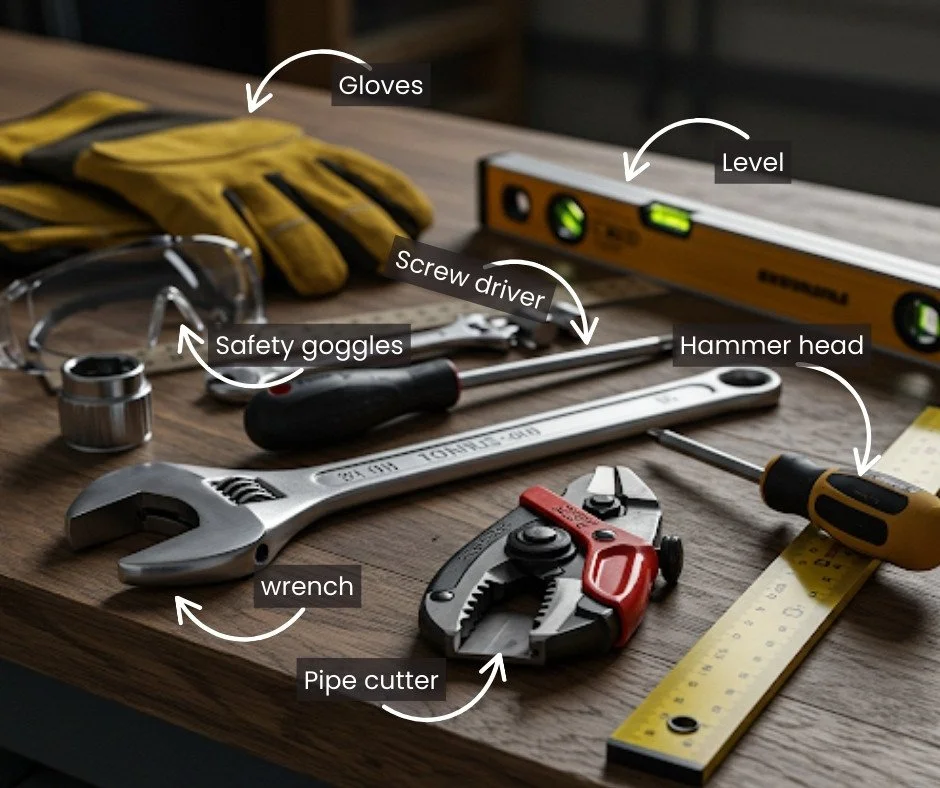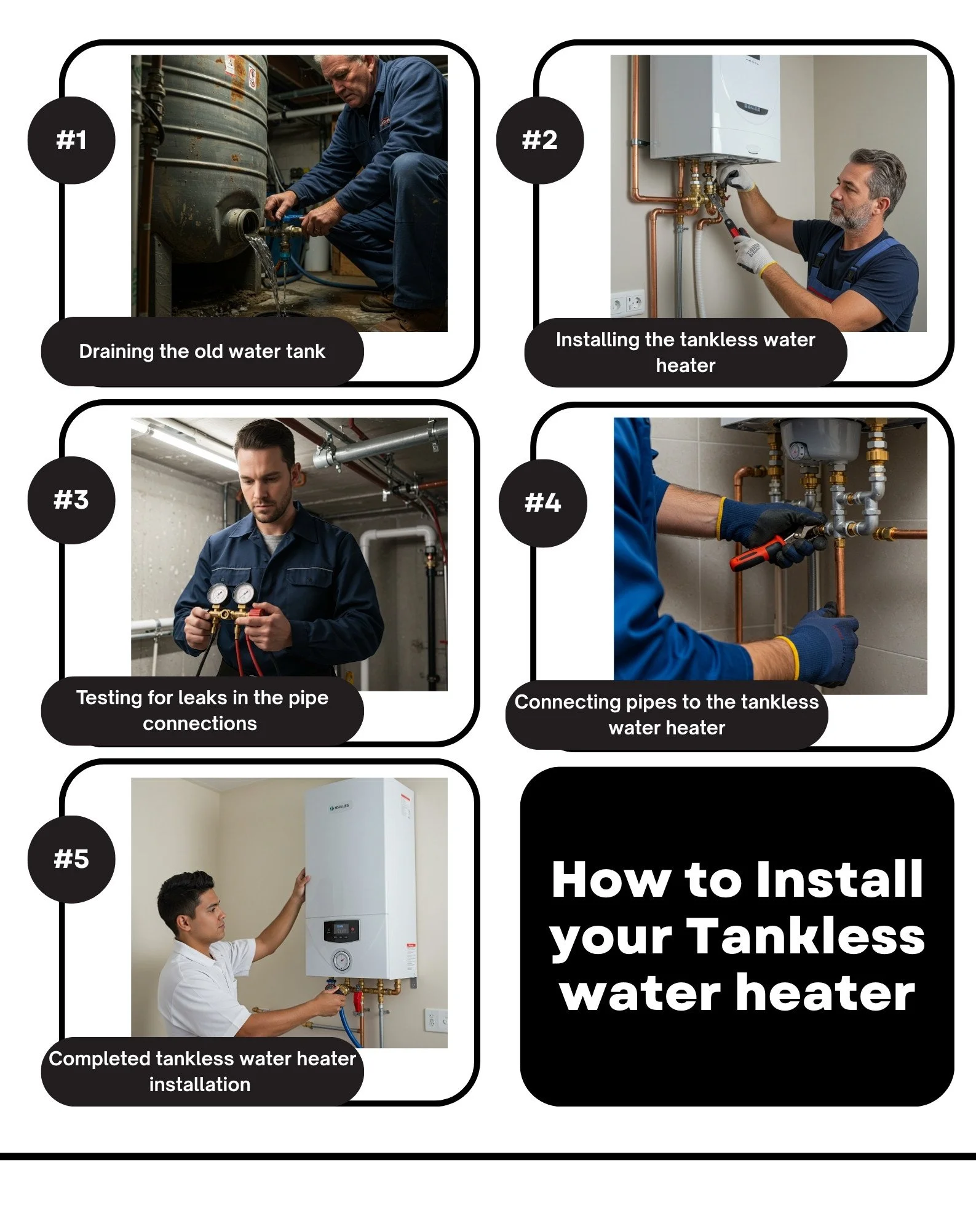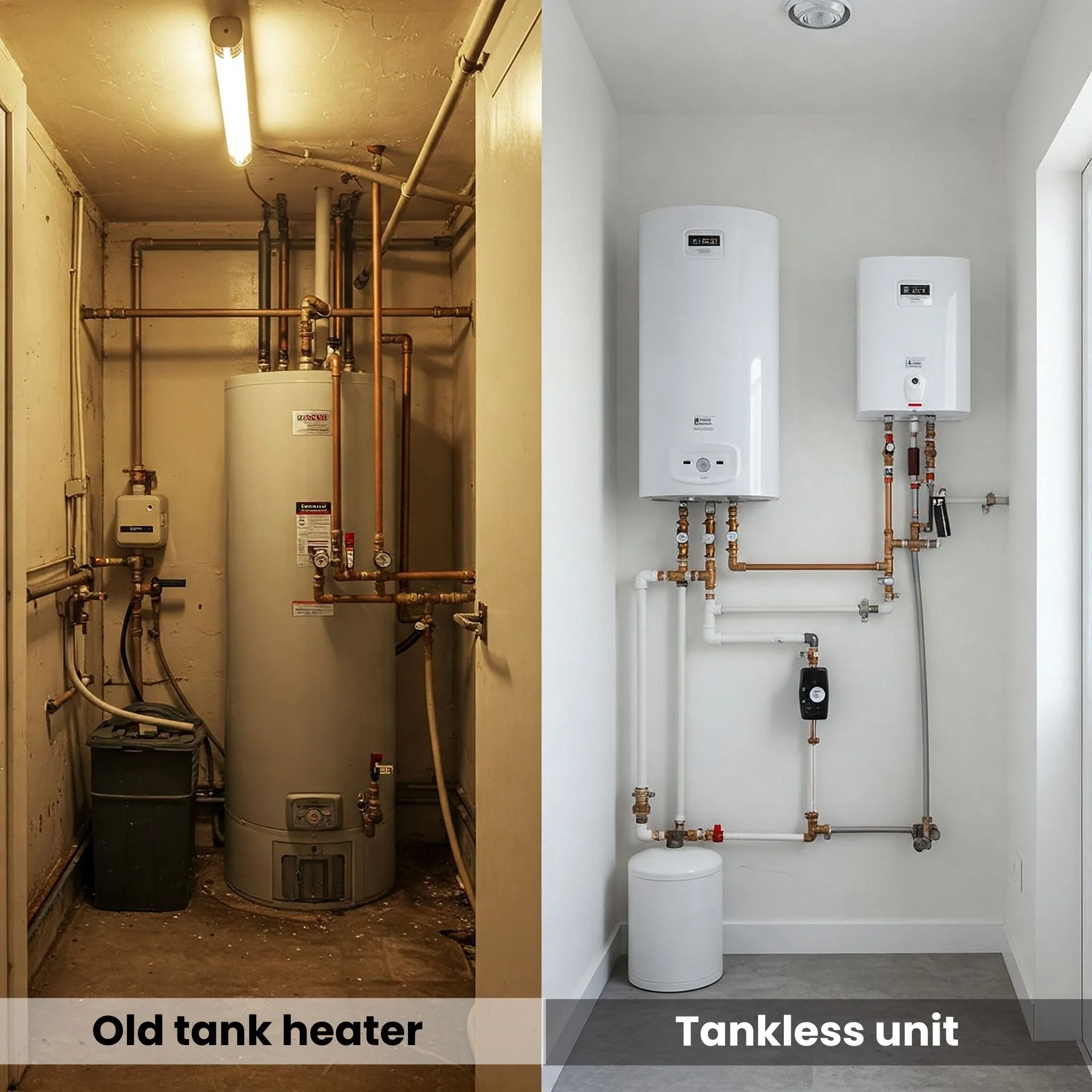Replace Water Heater with Tankless to Boost Efficiency and Save Money
If you're still stalling on whether to replace your water heater with tankless, here's a reality check: you're paying every month to heat water you never touch. It's like buying groceries, then throwing half of it away just to keep the fridge running.
Most folks don’t realize it, but that big metal barrel humming in the hallway is lazy. It works when it wants, leaks when it shouldn't, and retires early—on your dime.
And tankless? It waits quietly until you need it, delivers instantly, and doesn’t keep a tab running while you're asleep or at work. No bloated bills. No half-warm apologies.
This isn't about getting hot water faster. It's about stopping the slow bleed you're probably used to calling “normal.”
We’ve been polite long enough. Let’s tell the truth about tanks.
Why Switch to a Tankless Water Heater?
You know that tank water heater humming away in your garage is quietly torching your utility budget—slowly, consistently, and with a smugness only a glorified barrel of water could get away with.
See, most people don’t realize this: that tank doesn’t care if you’re home or not. It keeps heating. Constantly. Like a clingy ex that shows up just to make sure you're still paying attention.
This is why water heater upgrades aren’t just some nice-to-have wish list item. They’re a financial intervention, especially if you’re tired of dealing with issues like those we cover in our guide, 8 Common Water Heater Problems: A Homeowner’s Guide.
What You Actually Get With a Tankless Water Heater
Let’s not sugarcoat it—converting to tankless water heater is one of the few upgrades in your home that will immediately start paying its rent.
Here’s why:
Energy savings up to 34%, especially if your daily use sits below 41 gallons. If you’re running a mid-size household, that’s you.
Endless hot water. Not “a little longer than usual.” Not “probably enough for one more shower.” Endless. And no, that’s not a marketing buzzword. That’s just physics and flow rate.
Wall-mounted, space-saving bliss. Traditional tanks are the definition of “square footage killer.” But tankless units hang there like a polite guest. You barely know they exist—until you crank the tap and get liquid on demand.
Lifespan that actually feels adult. Most tank units give out—8 to 12 years tops. But a properly installed tankless heater? Expect 20+. That’s two decades of not thinking about your water heater every time your shower stutters.
Why Colorado Homes Especially Need to Wake Up
Colorado winters do not mess around. You’re dealing with frozen pipes, hard water, and groundwater temperatures that flirt with 40°F.
Which means your tank heater is pulling double shifts trying to reheat water. With a tankless system, you're heating on-demand—and not wasting energy on reheating a tank full of water that just sits there cooling off the minute you stop using it.
Tankless water heater replacement often leads to noticeable utility drops by the very next billing cycle. Yes, even in colder states.
Don’t Take Our Word For It (Seriously, Don’t)
Scan the reviews. It’s the same thing across the board: people are shocked that something so practical works so… well. Top brands are consistently racking up reviews that read like they paid people—but they didn’t. It’s just that good when you install the right model for your needs.
Sizing and Choosing the Right Tankless Water Heater
You don’t choose a water heater the way you pick a kitchen sponge. If you mess up the sizing, you'll end up either freezing mid-shampoo or paying for more capacity than your house will ever need. Neither of those ends well.
So yes, sizing a tankless water heater is the real thing.
Here’s what actually matters:
Flow rate (GPM): That’s gallons per minute. Each faucet, shower, or appliance you run at the same time adds to that number. Two showers and a sink running at once? You’re around 5–6 GPM right there.
Temperature rise: This one’s a Colorado special. Your incoming water might be 40°F in winter. If you want 120°F out of the tap (and you do), your heater has to deliver an 80°F temperature rise. Not all models can do that efficiently.
A correctly sized unit for a family of four in Colorado, for instance, might need 7 GPM at an 80°F rise. You’ll want that math done right by someone who isn’t just eyeballing it.
Gas vs. Electric: The Matchup That Actually Matters
Gas tankless heaters: Absolute beasts when you need high volume. More expensive up front, but they perform better for large households. They also tend to recover faster and handle cold groundwater better.
Electric models: Better for smaller homes or single-point use (like under the kitchen sink). They’re cheaper and easier to install, but less ideal for heavy-duty or whole-house use, especially in colder climates.
If you're planning to replace a 50-gallon tank, odds are you’re leaning gas—unless you love lukewarm regret.
Brands That Aren’t Playing Around
When it comes to tankless water heater replacement, you're putting your trust in a box that hides behind drywall. So pick the right one:
Rinnai – Gold-standard. Especially if you’re looking for durability and consistent performance in large homes.
Navien – Known for cutting-edge condensing technology and whisper-quiet operation. They’re not flashy, but they run like a Swiss watch.
Rheem – Solid all-rounder. Easier installs, good customer support, and both gas and electric options that don’t blow up your budget.
All of these are readily available in Colorado, which means you're not waiting two months for a backorder from Mars.
Tools and Materials You’ll Need (Don’t Wing This)
There’s no prize for guessing your way through a tankless install. You want to replace a tank water heater with tankless, not burn down your crawlspace or end up with a half-installed heater and a very wet, very silent regret.
You’ll need real gear—stuff that actually works. And yes, safety matters. Because those water heater upgrades won’t mean much if you forget a gas line wrench or forget goggles and lose a battle with pipe shavings.
The Non-Negotiable Tools
Adjustable wrench – For pipe fittings, and for convincing rusted bolts you mean business.
Pipe cutter – Don’t think your old hacksaw will cut it. It won’t. Not cleanly.
Screwdriver set – Ideally magnetic. Ideally, you know where yours are.
Level – No, eyeballing isn’t good enough. If your tankless hangs crooked, so does your credibility.
Gloves & goggles – Because copper shards and pressurized water don’t mix with eyeballs or skin.
The Materials That’ll Keep You from “Quick-Calling” a Plumber
Tankless water heater unit – Sized to your home’s flow rate. (Not just what’s on sale. This matters.)
Copper piping or PEX – Depending on your current setup and your level of patience with fittings.
Fittings/adapters – Especially if you’re doing a retrofit tankless water heater install in place of a 50-gallon tank.
Venting kit (for gas models) – No, you can’t just re-use the old flue.
Electrical wiring & breaker (for electric models) – Follow amperage specs. No guessing.
The One Thing People Always Forget (And Regret Later)
Permits.
Yes, you likely need one. In Denver and many other cities in Colorado, a plumbing permit is required for any serious water heater upgrades. That includes tankless water heater replacements. You can check Denver’s code portal here.
Skip this, and you risk fines, insurance voids, and inspection headaches. And for what—saving 20 minutes?
Step-by-Step: How to Replace Water Heater with Tankless
Now, this part’s critical: This isn’t a choose-your-own-adventure project. If you’re about to replace a 50-gallon tank with a tankless water heater, and you’re not following steps—real, logical ones—you’re setting yourself up for expensive calls and cold showers.
Here's how to replace your tank water heater with tankless without losing your temper (or your eyebrows).
Step 1: Size It Like You Mean It
You need to size the tankless water heater properly—based on:
Flow rate: How many showers, sinks, washers, etc. might run at the same time? Add those GPMs up.
Temperature rise: In Colorado, you may be heating from 40°F up to 120°F. That’s an 80°F rise.
Miscalculate this and you’ll either overspend or underperform. Either way: not smart.
Step 2: Turn Off What Keeps Things Alive
Shut off the water, then gas or electricity. Seriously—don’t get cocky. Drain the old tank fully before you touch a fitting.
Step 3: Remove the Old Heater
Disconnect:
Water lines
Gas lines (if applicable)
Electrical wiring (if electric)
Then carefully remove it. It’s heavy. It might still be wet. It will not go quietly.
Step 4: Prep the Spot for a Tankless Setup
Wall clear? Good. Got the mounting board secured? Better.
For gas units, confirm venting routes. A tankless retrofit isn’t plug-and-play. You’ll need new venting—typically stainless steel or PVC—and you’ll need to follow code.
Step 5: Hang and Hook Up the New Unit
Connect:
Cold water inlet and hot water outlet.
Gas line or electric wiring.
Venting assembly if needed.
Double-check flow direction, line tightness, and grounding. You’re not guessing anymore—you’re installing a permanent appliance.
Step 6: Test Before You Celebrate
Turn water back on. Check every connection.
Power it up. Let it run. Don’t walk away until you’ve tested:
A shower
A sink
A second hot water source
Make sure it keeps up. And check for leaks, hissing, or bad smells. No shortcuts here.
Step 7: Insulate Your Lines (Especially in Colorado)
You’ve done the work—don’t let cold air ruin it. Wrap exposed hot water lines with pipe insulation, especially in basements or crawl spaces. This preserves heat and prevents freezing—both of which keep your heater working like it should.
Final Safety Reminder (No, You’re Not Done Yet)
Follow the manufacturer’s instructions to the letter.
Respect local codes.
If anything feels off—smells like gas, trips a breaker, leaks unexpectedly—shut it down and get a pro in.
There’s a line between DIY and foolish. It’s thinner than you think.
Common Challenges and Solutions
Let’s get one thing straight: yes, converting to a tankless water heater has its friction points. But if you're hearing horror stories about failed installs, gas leaks, or blown fuses—it’s usually because someone winged it and skipped the prep.
There are only three real hurdles that trip people up. Here they are—along with what to actually do about them.
1. The Gas Line That’s Just... Not Built for It
This one’s predictable. Gas tankless water heaters need more BTUs than your old tank unit ever dreamed of. So if you’re reusing your current gas line without checking flow rate capacity first, you might be setting yourself up for a heater that whispers warm water instead of delivering it.
What to do:
Call a licensed plumber and have them check your line diameter. If it’s not up to spec, upgrading is doable. It’s not cheap, but it’s also not optional. Performance depends on it. Don't assume—verify.
2. The Electrical Panel Throwing a Silent Tantrum
If you're going electric, here's your warning: some tankless units pull serious amps. As in, “needs its own dedicated circuit” level serious. Your 20-year-old electrical panel might just trip out on day one.
What to do:
Get an electrician (not your neighbor with a multimeter). Let them evaluate if your panel can handle the load, or if you need to expand capacity. And no, adding a bigger breaker without a load calculation isn’t a shortcut—it’s a fire hazard.
3. Venting That Has Nowhere to Go
Gas units need proper venting. If your install space is tight or boxed in, that classic dual-pipe setup may not fit without turning your drywall into Swiss cheese.
What to do:
Use a concentric vent kit. It handles intake and exhaust through the same hole. Fewer cuts, more flexibility. And they’re up to code in Colorado, as long as the unit is UL listed and the termination is done right.
You’re not just replacing a tank water heater with a tankless to save space. You’re upgrading the whole flow system. If these are your sticking points, you’re already asking the right questions. And solving them is how you avoid regrettable weekends and emergency calls.
The (Real) Costs and (Surprisingly Fast) Payoff of Tankless Water Heaters
The worst lie about tankless water heaters is that they’re just “too expensive.”
What You Pay Upfront
Unit cost: $1,000–$3,000 depending on size and brand. You’ll pay more for condensing models and recirculation features.
Installation: $500–$2,000 depending on how complex the retrofit is. If you're dealing with new venting, panel upgrades, or pipe rerouting, it creeps higher.
Doing it yourself?
You’ll save labor, sure. But if you’ve never touched gas lines or high-voltage circuits, that’s a gamble. Don’t be the person that posts their mistake on Reddit and becomes a cautionary tale.
What You Save Long Term
According to Energy.gov, homes using moderate hot water (under 41 gallons daily) can expect up to 34% greater energy efficiency.
That translates into:
15–20% lower energy bills annually
$100–$300 per year in real dollars
And in Colorado, you can stack that with rebates from Xcel Energy and other utility programs. That’s money back in your pocket today, not just “eventual savings.”
Lifespan = Fewer Headaches
Tank units give out around year 10. If they make it to 12, they want a medal. Tankless water heaters last 20+ years, especially if you flush them yearly and treat your hard water properly.
So yeah—replacing a tank water heater with a tankless isn’t just about this month’s bill. It’s about not calling your plumber again a decade from now with the same exact problem.
Conclusion
This is a hard reset on everything you've silently accepted about hot water: inconsistent pressure, reheating waste, limited supply, emergency replacements at the worst time.
Converting to a tankless water heater means:
Hot water when you want it—without rationing.
More space, fewer failures, lower bills.
A system that doesn’t wake up at 3 a.m. just to keep 40 gallons lukewarm for no one.
If you're even halfway serious about making your home more efficient, more durable, and less frustrating, this is one of the lowest-hanging wins. Period.
Not convinced? Don’t just take our word for it. Tankless water heater reviews for the best tankless water heater brands—Rinnai, Navien, Rheem—are publicly out there. People aren’t buying these units for fun. They’re buying them because they work.
And if the idea of wrenching your own gas line freaks you out? Fair. A qualified plumber can knock the install out in a day—and get it right the first time.
So yes, it’s time. Replace your water heater with tankless. Do it smart. Do it once. And finally stop being held hostage by an appliance that aged out before your thermostat did.
Frequently Asked Questions
-
A: Yes, if you value long-term savings, efficiency, and endless hot water. Tankless units use less energy, last twice as long, and take up less space. While the upfront cost is higher, the payoff in utility savings, reliability, and home resale value makes it a smart water heater upgrade for most households.
-
A: Converting to a tankless water heater typically costs between $1,500 and $5,000, depending on the unit, installation complexity, and whether upgrades like gas line resizing or venting are needed. DIY can lower costs, but professional installation is strongly recommended for safety and code compliance.
-
A: The biggest drawback is the upfront cost and potential need for plumbing or electrical upgrades. Tankless units also may struggle with simultaneous high-demand usage if improperly sized. But with the right unit and setup, these issues are easily avoided.
READ MORE…
8 Common Water Heater Problems: A Homeowner’s Guide
How Does Plumbing Work? What Your Plumber Knows That You Don't
Top 10 Reasons for Low Water Pressure in Your Home
The Ultimate Guide to Fixing a Leaky Sink Drain Pipe





